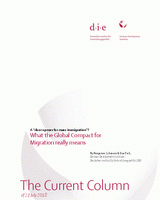A “door opener for mass immigration”?
What the Global Compact for Migration really means
Schraven, Benjamin / Eva DickThe Current Column (2018)
Bonn: German Development Institute / Deutsches Institut für Entwicklungspolitik (DIE), The Current Column of 23 July 2018
Bonn, 23 July 2018. Around a week ago the member states of the United Nations (UN) agreed upon a “Global Compact for Safe, Orderly and Regular Migration”. In this age of drawbridge-raising policies of Seehofer, Salvini, Trump and the like this appears to be a minor miracle. Supporters of the treaty such as UN Secretary-General António Guterres are already referring to it as a truly historic agreement. In contrast, the German right-wing populist party AFD and the right-wing media view the Global Com compact for Migration as an instrument that opens the door to (hundreds of) millions of immigrants to Europe from Africa. The USA cancelled its participation in the negotiations in advance and Hungary has now also announced that it is withdrawing from the compact. So what is behind this global agreement, and what can we expect from it?
The starting point for the Migration Compact – as with the Global Compact on Refugees, which is currently still being negotiated – was a summit on flight and migration that took place under the aegis of the UN in September 2016, with Barack Obama issuing the invitation. In contrast to refugee policy, where there are specific global and regional (protection) conventions and the UN refugee body UNHCR monitors observance, no comparable set of rules exists for migration and there is no world or UN migration organisation. Contrary to a widely-held misconception, this role is not held by the International Organization for Migration (IOM). Instead, IOM is rather a service agency to member states for migration management, consultancy and repatriation. A (binding) treaty for the protection of migrants against human rights breaches or exploitation also does not exist to date.
The Global Compact for Migration, which essentially comprises 23 goals, attempts to close this gap. The contractual text places particular focus on protection, the rights and improved living and working conditions of migrants and their families. Combating the exploitation of labour, human trafficking and discrimination as well as expanding the options for regular migration represent key elements of the compact. Civil society organisations in particular were successful here in promoting their goals in the negotiating process. Moreover, the compact calls for an improved data management regarding international migration processes, it promotes the tackling of economic, environment-related and political causes of forced migration and stresses the goal of “integrated, secure and coordinated” border management.
Particularly important is the underlying message of this treaty, which is certainly no door opener for uncontrolled mass immigration to Europe or anything alike. Instead, it is a sober acknowledgement of what migration actually is. Namely a global reality that cannot simply be halted by closing borders or spending a few billion Euros more on development aid. The compact also illustrates what migration actually can be, namely, as it is stated in the text, a “source of global prosperity, innovation and sustainable development”. The global amount of remittances, which has been increasing for years, is just one example of this.
However, the migration compact is not binding. In principle, it is merely a declaration of intent. One central prerequisite for more “safe, orderly and regular migration” – as foreseen by the UN sustainability goals – is therefore the political will for improved migration management and achieving the goals of the compact. The good news is that many countries are sure to follow this path to implementation. Global South countries of origin, transit and emigration such as Mexico, Morocco and Bangladesh are sure to have an intrinsic interest in improved migration policy co-operation. Because in Europe, in spite of the strident discussions on transit centres or the (refused) taking in of refugees, one thing should not be forgotten: A large proportion of international migration movements takes place within the regions of the Global South. Migration from Africa to Europe represents just a small portion of the overall African migration. Two thirds of African migrants live in other African countries.
To ensure that the implementation of the compact is successful - in the face of powerful opposition - some further aspects are also essential. For example, an upgrading of the IOM or the creation of a UN migration secretariat with a policy forming (not merely coordinating) function is urgently required. Because international migration policy needs to be connected far more closely to development, climate and environmental policies, which can also influence migratory movements. Regional organisations, which play a key role in the regulation of regional migration systems, need to be reinforced within the global migration architecture. This also applies for cities and municipalities. Because in developing and emerging countries in particular they are the central locations and actors for the reception and integration of migrants.


